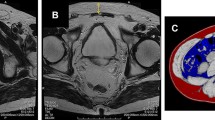Abstract
Background
Computed tomography-defined low skeletal muscle mass is associated with oncological outcomes in patients with prostate cancer. However, its association with the outcomes of hormone-treated metastatic castration-sensitive prostate cancer remains unclear. We aimed to determine the association between metastatic castration-sensitive prostate cancer and psoas muscle parameters.
Methods
We retrospectively reviewed 121 patients with N1 and/or M1 metastatic castration-sensitive prostate cancer who underwent primary androgen deprivation therapy between 2005 and 2021, either by administration of luteinizing hormone-releasing hormone agonist/antagonist or by surgical castration accompanied by bicalutamide, a first-generation antiandrogen. Before treatment administration, the psoas muscle index at the level of the third lumbar vertebra (psoas muscle area [cm2]/height2 [m2]) and the mean Hounsfield units of the psoas muscle were evaluated using non-contrast computed tomography and in relation to oncological outcomes.
Results
The median follow-up was 56.9 months. Furthermore, during follow-up, 82 (67.7%) and 53 (43.8%) patients progressed to castration-resistant prostate cancer and died, respectively. Multivariate analysis of castration-resistant prostate cancer-free survival and overall survival showed significant differences in the Gleason score, clinical N-stage, and psoas muscle index (median cutoff: 3.044 cm2/m2).
Conclusions
Pretreatment psoas muscle index is an independent predictor of poor castration-resistant prostate cancer-free survival and overall survival in patients with N1 and/or M1 metastatic castration-sensitive prostate cancer.

Similar content being viewed by others
References
Meyer HJ, Wienke A, Surov A (2022) CT-defined low-skeletal muscle mass as a prognostic marker for survival in prostate cancer: a systematic review and meta-analysis. Urol Oncol 40:103.e9-103.e16
Cruz-Jentoft AJ, Bahat G, Bauer J et al (2019) Sarcopenia: revised European consensus on definition and diagnosis. Age Ageing 48:16–31
Sugino Y, Sasaki T, Kato M et al (2021) Prognostic effect of preoperative psoas muscle Hounsfield unit at radical cystectomy for bladder cancer. Cancers 13:5629
Xin YX, Xiao MJ, Qin X et al (2022) Skeletal muscle change during neoadjuvant therapy and its impact on prognosis in patients with gastrointestinal cancers: a systematic review and meta-analysis. Front Oncol 27:892935
Kreher R, Hinnerichs M, Preim B et al (2022) Deep-learning-based segmentation of skeletal muscle mass in routine abdominal CT scans. In Vivo 36:1807–1811
Sasaki T, Sugino Y, Kato M et al (2020) Pre-treatment ratio of periprostatic to subcutaneous fat thickness on MRI is an independent survival predictor in hormone-naïve men with advanced prostate cancer. Int J Clin Oncol 25:370–376
Lopez P, Newton RU, Taaffe DR et al (2022) Associations of fat and muscle mass with overall survival in men with prostate cancer: a systematic review with meta-analysis. Prostate Cancer Prostatic Dis 25:615–626
Kashiwagi E, Shiota M, Masaoka H et al (2020) Relationship between body composition and hormone sensitivity for androgen deprivation therapy in patients with metastatic prostate cancer. Prostate Int 8:22–26
Ikeda T, Ishihara H, Iizuka J et al (2020) Prognostic impact of sarcopenia in patients with metastatic hormone-sensitive prostate cancer. Jpn J Clin Oncol 50:933–939
Iwamoto G, Kawahara T, Miyai T et al (2020) A lower psoas muscle index predicts a poorer prognosis in metastatic hormone-naïve prostate cancer. BJUI Compass 2:39–45
Muñoz-Rodríguez J, Domínguez A, Rosado MA et al (2021) Effect of muscle density in patients with metastatic prostate cancer administered androgen deprivation therapy. Endocrinol Diabetes Nutr (Engl Ed) 68:92–98
Cornford P, Bellmunt J, Bolla M et al (2017) EAU-ESTRO-SIOG guidelines on prostate cancer. Part II: Treatment of relapsing, metastatic, and castration-resistant prostate cancer. Eur Urol 71:630–642
Soloway MS, Hardeman SW, Hickey D et al (1988) Stratification of patients with metastatic prostate cancer based on extent of disease on initial bone scan. Cancer 61:195–202
Miyake H, Matsushita Y, Watanabe H et al (2019) Prognostic significance of time to castration resistance in patients with metastatic castration-sensitive prostate cancer. Anticancer Res 39:1391–1396
Narita S, Hatakeyama S, Takahashi M et al (2020) Clinical outcomes and prognostic factors in patients with newly diagnosed metastatic prostate cancer initially treated with androgen deprivation therapy: a retrospective multicenter study in Japan. Int J Clin Oncol 25:912–920
Miyazawa Y, Sekine Y, Arai S et al (2021) Prognostic factors in hormone-sensitive prostate cancer patients treated with combined androgen blockade: a consecutive 15-year study at a Single Japanese Institute. In Vivo 35:373–384
Sasaki T, Takahashi T, Sekito S et al (2023) Pretreatment lymphocyte to C-reactive protein ratio: an independent predictor of overall survival in metastatic hormone-naïve prostate cancer patients. Clin Genitourin Cancer 21:e474–e484
Baumgartner RN (2000) Body composition in healthy aging. Ann N Y Acad Sci 904:437–448
Pedro PR, Tasmania DPS, Diego IV et al (2022) Prognostic impact of sarcopenia in patients with advanced prostate carcinoma: a systematic review. J Clin Med 12:57
Mason RJ, Boorjian SA, Bhindi B et al (2018) The association between sarcopenia and oncologic outcomes after radical prostatectomy. Clin Genitourin Cancer 16:e629–e636
Pak S, Park SY, Shin TJ et al (2019) Association of muscle mass with survival after radical prostatectomy in patients with prostate cancer. J Urol 202:525–532
Ohtaka A, Aoki H, Nagata M et al (2019) Sarcopenia is a poor prognostic factor of castration-resistant prostate cancer treated with docetaxel therapy. Prostate Int 7:9–14
Lee JH, Jee BA, Kim JH et al (2021) Prognostic impact of sarcopenia in patients with metastatic hormone-sensitive prostate cancer. Cancers 13:6345
Author information
Authors and Affiliations
Corresponding author
Ethics declarations
Conflict of interest
The authors declare that they have no conflict of interest.
Additional information
Publisher's Note
Springer Nature remains neutral with regard to jurisdictional claims in published maps and institutional affiliations.
About this article
Cite this article
Owa, S., Sasaki, T., Ikadai, R. et al. Psoas mass index at the level of the third lumbar vertebra on computed tomography is a prognostic predictor for metastatic castration-sensitive prostate cancer. Int J Clin Oncol (2024). https://doi.org/10.1007/s10147-024-02514-2
Received:
Accepted:
Published:
DOI: https://doi.org/10.1007/s10147-024-02514-2




